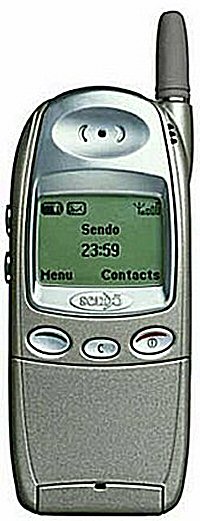Test report and technical data Sendo D800
Nice design with sadly no valuable interior.
Positive about the Sendo D800: chic design
Negative about the Sendo D800: lousy processing, few features
The British sure do try to keep up with the international mobile phone-market, but it seems as if it does not want to work the way they would want it to. Many simple Sendo-models completely failed in practical experience and were therefore merciless massacred by the German and Finnish competitors. Eventually Sendo put together all its knowledge and power in one model, the Sendo D800. The result? Dubious.
Purely optical, the Sendo D800 convinces with a progressive design.
Setting aside an angular body, the small dimensions and the slight weight of the Sendo D800 speak for the Sendo D800. With precise dimensions of 123 x 45 x 19 mm one can not complain about the Sendo D800, neither about the weight of the Sendo D800. The antenna is not yet integrated in the body of the Sendo D800.
The 6-lined display of the Sendo D800 is something to be happy about, although it is not yet a colour-display. The display of the Sendo D800 merely glimmers in blue colour. The keypad of the Sendo D800 is covered by a flap, which has to be opened each and every time before accessing any key. Kinda annoying...
The processing of the Sendo D800 is absolutely lousy, neither does the battery fit in tightly in the body of the Sendo D800, nor is the flap steady and strong. Sure no plus in that term for the Sendo D800.
In exchange, the Sendo D800 is equipped with a good battery, which enables the user a talk-time of three hours and a stand-by time of roughly 300 hours.
Operating the Sendo D800 is made most easy. Several direct links are helpful for a breezy handling of the Sendo D800.
I do hope that the British hope for more from a mobile than what the Sendo D800 offers. The functions of the Sendo D800 are really narrow, not only are there only very little features but also do they not function properly.
One can find 50 predefined ringer-tones on the Sendo D800, a vibratory alert, games and a calendar with an alarm. Certainly the Sendo D800 covers a T9-software. There is as well a small telephone book on the Sendo D800 in addition to the SIM-card. Its entries can be arranged by group and one can access them via voice-dialling.
The Sendo D800 does not own a WAP-browser, however the Sendo D800 tries to balance that with an integrated modem. In addition to that there are no interfaces at all to be found with the Sendo D800. That's the point where I ask myself, why transferring data between the Sendo D800 and PDAs is made possible, since this function actually exceeds the average interfaces and a WAP-browser.
Over all the Sendo D800 does not rate all too bad, the weird assignment of functions is just a bit confusing. I would not have minded a better processing of the Sendo D800 either. The ease of use of the Sendo D800 is again a plus, which is however only made possible by reducing the offer of features of the Sendo D800. I guess the Sendo D800 is an average mobile with a bad processing, but a comparable appealing design.
Test-review of the Sendo D800:
Technical features: ++
Reception quality: +++
Battery stand-by time: +++
Design: +++
Ease of use: +++
Value for money: +++
Overall rating: +++
++++/excellent, +++/good, ++/satisfactory, +/poor
All texts, pictures and other data © 2003, Universal Boards GmbH & Co KG.
Multiplication or replication for personal use or distribution
without the agreement of Universal Boards GmbH & Co KG. is prohibited by law.

